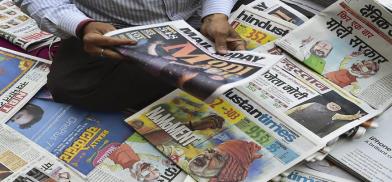Newspapers struggle to survive in pandemic-induced lockdown
Newspapers are facing an uphill task to maintain their readership as India is in a complete lockdown till the middle of April because of the COVID-19 pandemic

Newspapers are facing an uphill task to maintain their readership as India is in a complete lockdown till the middle of April because of the COVID-19 pandemic. A shutdown that prevents vendors from delivering newspapers to the buyers amid rumours that the newspaper itself can carry the novel coronavirus have forced publishers to drastically reduce their printing and circulation.
As the pandemic infected over 700 Indians, with rising casualties, its immediate impact was observed in the circulation of newspapers in Mumbai, where vendors stopped working to deliver newspapers. The city’s main vendors’ association formally met with the management of all print media houses and resolved to suspend publications, thereby stopping newspaper delivery state-wide.
However, the management of The Times of India, The Indian Express, The Hindu, Hindustan Times, Mid-Day and others have clarified that even though no physical editions would hit the stands because of the new-found restrictions, their newspapers would be available on the internet. Acclaimed news magazine Outlook also suspended its print edition making the digital edition available for its readers.
After Mumbai, it was the turn of residents of Bangalore, Hyderabad, Guwahati, Imphal, Agartala, Aizawl and other parts of Northeast to miss their morning newspapers. The Guwahati newspaper hawkers’ association, Manipur hawkers’ association, Tripura and Mizoram based newspaper vendors separately resolved that they would not distribute the newspapers fearing the virus infection.
The Northeast region, for example, sees the publication of over 50-morning dailies in different languages including English, Hindi, Assamese, Bengali, Boro, Meitei, Karbi, Khasi, Mizo, Nagamese and Nepali. Social media messages suggesting that newspapers are potential carriers of coronavirus have created panic among media personnel, newspaper agents and hawkers, causing a stop to newspaper deliveries.
The World Health Organization (WHO) has, however, asserted that newspapers are safe and do not spread the virus. The paper used by print media outlets are produced in highly automated mills, with no human interface. The likelihood of an infected person contaminating commercial goods is low and the risk of catching the virus from a package that has been moved, travelled, and exposed to different conditions and temperature is also low.
However, physical editions of newspapers have been stalled because of COVID-19 fears. Reports have been coming in from different parts of the globe; from Sylhet (Bangladesh) to Colombo (Sri Lanka), Rabat (Morocco) to Rome (Italy), other African and European capitals along with American cities witnessing the temporary suspension of newspaper production and movement to their digital platforms.
India, the largest democracy in the world, has over 82,000 registered newspapers with a cumulative daily circulation of 110 million. The print media is estimated to be a Rs 32,000 crore (5 billion USD) industry. As Indian literacy rates have improved to over 75%, more citizens have developed the capacity and resources to access newspapers and digital forums. More middle class Indian families are now using the internet for various activities for the first time in their lives.
Prior to declaring the 21-day nationwide lockdown to fight against COVID-19, Modi interacted with some selected media barons in the country and received suggestions from them over the issue. It is quite amazing that Modi did not organize such interactions with news media owners prior to the shocking announcement of demonetisation (2016) and major announcements like the abrogation of Article 370 from Jammu & Kashmir (2019) and for the Citizenship Amendment Act 2019.
Various print media houses have opted to boost their presence in the digital media. As millions of Indians use smartphones with internet connectivity, media owners have come to realise that readers would prefer to get their news and information content almost free from digital platforms rather than paying for newspapers or even news channels. Hence, advertisers have also substantially shifted their focus to the digital media space.
Already, a newspaper in India is sold in the market at a price lower than its actual cost. The deficit (and profit) is managed by the advertisers. They want a newspaper to reach more people (with a price or even without it) so that their products get the necessary visibility. Without circulation, the advertisers would not support the newspapers anymore. No distribution of newspapers (even if published) simply means no advertisements (read financial support) for the print media outlets.
The situation can become particularly alarming for regional newspapers like those in Guwahati, Imphal, Agartala, Aizawl and elsewhere, as the owners may not be able to sustain their media houses for too long. It would directly impact their employees, including thousands of journalists in the region. Media bodies have issued statements against rumours that newspapers can be potential carriers of the coronavirus. They have also appealed to the government to support media houses in this time of crisis.
Many social media users, in turn, have asked media houses whether they could assure their readers of authenticated, credible and balanced news items. COVID-19 is a time-bound disaster. The world would probably return to normalcy after some months. But will traditional media houses ever get their dedicated readers back in the post-corona era is a difficult question to answer at this moment.
(The author is a Northeast India based media activist)









Post a Comment